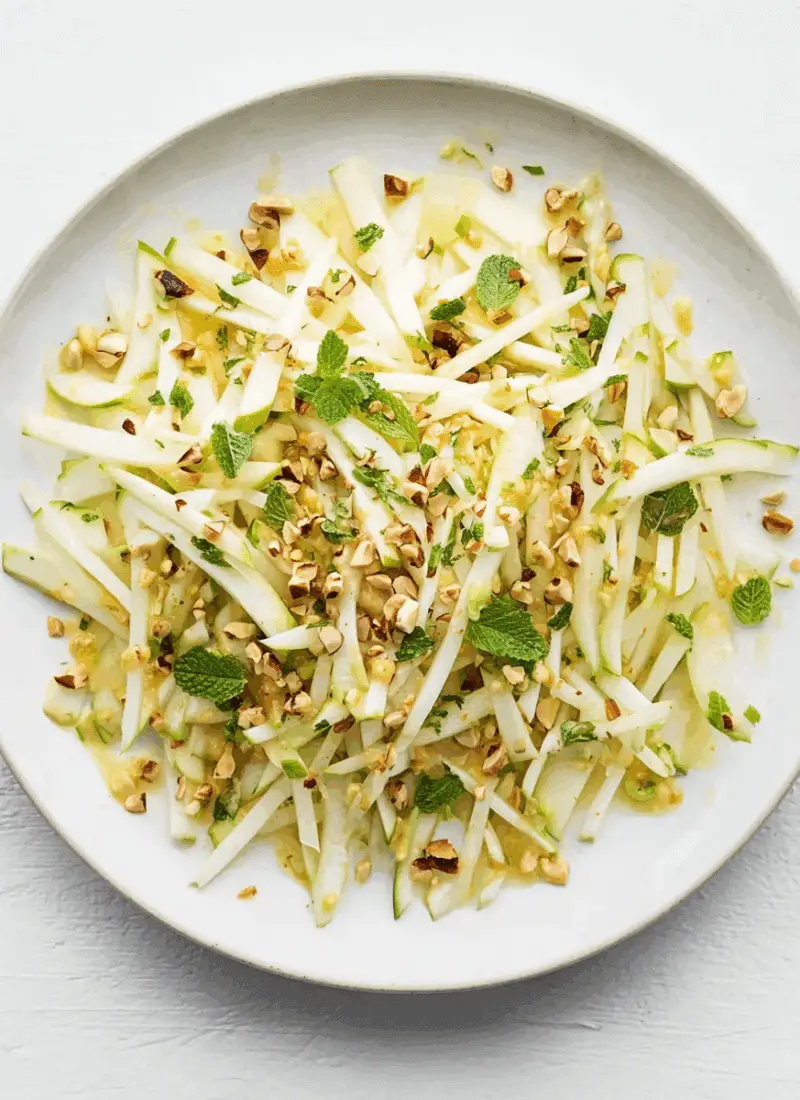This Kohlrabi and Apple Salad is a crisp, vibrant dish that pairs the earthy crunch of kohlrabi with the natural sweetness of apples. Accented by a tangy vinaigrette and rounded out with fresh herbs and optional nuts or cheese, it’s a refreshing choice for warm weather or as a light, palate-cleansing side. This salad offers a delightful contrast of textures and flavors sweet, tart, crunchy, and juicy making it a standout addition to any meal.
FULL RECIPE
Ingredients
- 2 medium kohlrabi bulbs, peeled and julienned
- 2 medium apples (e.g., Honeycrisp or Fuji), cored and thinly sliced or julienned
- 1 tablespoon lemon juice (to prevent apple browning)
- ¼ cup chopped fresh parsley or mint
- 2 tablespoons extra-virgin olive oil
- 1 tablespoon apple cider vinegar or white wine vinegar
- 1 teaspoon honey or maple syrup
- Salt and freshly ground black pepper, to taste
- Optional: ¼ cup crumbled feta or goat cheese
- Optional: ¼ cup chopped toasted walnuts or almonds
Directions
- Peel the kohlrabi and slice it into matchsticks or use a mandoline for even thin strips.
- Core the apples and slice them into thin matchsticks. Toss them in lemon juice to prevent browning.
- In a large mixing bowl, combine the julienned kohlrabi and apples.
- In a small bowl or jar, whisk together olive oil, vinegar, honey (or maple syrup), salt, and pepper to create the dressing.
- Pour the dressing over the salad and toss gently to combine.
- Add chopped parsley or mint and mix well.
- Just before serving, sprinkle with crumbled cheese and toasted nuts if desired.
- Serve immediately for the freshest flavor and crunch, or refrigerate for up to 2 hours to allow flavors to meld.
Nutrition Facts
- Calories: 150
- Total Fat: 10g
- Saturated Fat: 1.5g
- Cholesterol: 0mg
- Sodium: 80mg
- Total Carbohydrates: 15g
- Dietary Fiber: 4g
- Sugars: 9g
- Protein: 2g
- Vitamin C: 45% DV
- Vitamin A: 6% DV
- Calcium: 4% DV
- Iron: 4% DV
Nutritional Benefits of Kohlrabi
Kohlrabi is an underrated vegetable in the cabbage family that boasts a rich nutritional profile. It’s particularly high in fiber, vitamin C, and antioxidants, making it excellent for immune support and digestive health. Low in calories and high in water content, kohlrabi is ideal for weight management and hydration. Its slightly sweet and peppery flavor also contributes to its appeal in raw preparations like this salad, where its nutrients remain intact. The crunchy texture provides satiety and makes it a fantastic low-carb alternative to starchier vegetables.
Why Apples Complement Kohlrabi
The addition of apples to this salad is not just for sweetness they play a key role in balancing flavor and texture. Apples bring a juicy, tender contrast to the crispness of kohlrabi. Their natural sugars offset the slight bitterness or spiciness that kohlrabi can have, especially when raw. Varieties like Honeycrisp, Fuji, or Pink Lady work well due to their firmness and bright, tart flavor. In a salad that lacks traditional leafy greens, apples step in to create that refreshing burst that makes each bite exciting and flavorful.
The Role of Acidity and Sweeteners in the Dressing
The vinaigrette in this salad typically includes vinegar and a touch of honey or maple syrup, and these components serve a crucial purpose. Vinegar whether apple cider or white wine—introduces acidity that sharpens and lifts the overall flavor profile of the salad. Meanwhile, a small amount of honey or syrup tempers that sharpness, echoing the sweetness of the apples and creating a more rounded taste. This balance between acid and sweet is especially important in raw salads, where bold contrasts help bring the ingredients together harmoniously.
Choosing Herbs to Elevate Freshness
Fresh herbs such as parsley or mint are more than just a garnish in this salad; they offer aromatic depth and elevate the freshness of each mouthful. Parsley lends a grassy, peppery undertone that pairs well with kohlrabi, while mint adds a bright, cooling note that enhances the salad’s refreshing nature. Either herb or even a blend of both—can shift the flavor toward different culinary traditions. For instance, parsley might lend a Mediterranean touch, while mint evokes Middle Eastern or Southeast Asian flavor profiles.
Optional Add-Ins for Texture and Flavor
To add complexity to this salad, optional ingredients like crumbled feta or goat cheese and toasted nuts are excellent choices. The cheese introduces creaminess and a salty tang that contrasts beautifully with the sweetness of the apples. Nuts like walnuts or almonds contribute crunch, richness, and a nutty aroma that deepens the overall flavor. These add-ins not only diversify the textural experience but also increase the protein and healthy fat content, making the salad more satisfying as a standalone meal.
Ideal Pairings with Main Courses
Kohlrabi and apple salad is versatile enough to serve alongside a variety of main dishes. It pairs particularly well with grilled meats such as chicken, pork, or fish, as its crisp, cool texture balances richer, warm proteins. For vegetarian pairings, it complements grain-based mains like quinoa patties, lentil loaves, or stuffed bell peppers. Because of its brightness, the salad is also great for cutting through heavier or creamy dishes, offering a refreshing palate cleanser between bites.
Seasonal Availability and Best Times to Make
Both kohlrabi and apples are widely available in the fall, making this salad a perfect early autumn dish. However, because kohlrabi stores well and apples are often available year-round, the salad can be enjoyed in most seasons. Spring versions may lean lighter with fresh mint and early-season apples, while autumn versions may feature heartier additions like roasted squash seeds or blue cheese. This flexibility makes the salad a year-round staple that can adapt to seasonal produce and flavor profiles.
Serving Tips for Maximum Enjoyment
For the best texture and flavor, this salad should be served chilled but not overly cold. Allowing it to sit for 10–15 minutes after mixing lets the flavors meld while preserving crispness. If serving at a gathering, consider plating it on a chilled platter or bowl to keep it cool. A light drizzle of additional dressing or a finishing touch of herbs or cracked pepper right before serving adds visual appeal and freshness. The salad can be served in individual portions or as part of a buffet spread.
Storage and Make-Ahead Tips
This salad can be prepared a few hours in advance and stored in the refrigerator, but it’s best eaten the same day for optimal texture. The acid in the dressing helps prevent the apples from browning, while the hardy nature of kohlrabi means it won’t wilt quickly. If you plan to include cheese or nuts, add them just before serving to prevent sogginess. Leftovers can be kept in an airtight container for up to two days, though the texture of the apples may soften slightly over time.
Cultural Variations and Inspiration
While this version is a modern take, kohlrabi salads have roots in many European and Asian cuisines. In Germany and Eastern Europe, raw kohlrabi is often used in slaws or paired with creamy dressings. In parts of India, kohlrabi known as “nolkhol” is used in chutneys and fresh relishes. The apple pairing gives it a more Western twist, but the salad can easily be adapted to different cuisines by adjusting the herbs and dressings think sesame oil and soy for Asian flair, or yogurt-based sauces for Mediterranean styles.
Conclusion
The Kohlrabi and Apple Salad is a celebration of freshness, texture, and balance. By combining simple, nutrient-rich ingredients with a thoughtfully crafted dressing and flexible flavor boosters like herbs, nuts, and cheese, this salad becomes more than just a side dish it transforms into a versatile, crave-worthy component of any meal. Whether served at a picnic, paired with a hearty entrée, or enjoyed as a light lunch, this salad proves that raw vegetables can be just as exciting and satisfying as cooked ones.








